Wood-Gormley beam carving page

The Wood-Gormley beam carving page

In 1995, as Wood-Gormley Elementary in Santa Fe, NM was approaching
its 70th year, plans were being made for a full-scale remodeling. The
remodeling ended up as a 4+ million dollar project, and it was essentially
run by a committee of volunteers, consisting of the
principal, parents and teachers, a representative of the school district,
and the architect.
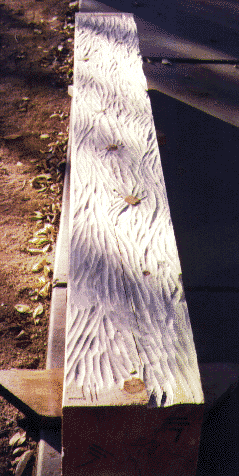 |
| The surfaces of unsculpted
beams were chipped to give them a 'worked' look, and to rid them of dirt
and grime |
Architects Santa Fe was chosen for the design, where the project
there was
headed by
Christopher Purvis. When Christopher left the firm, Marybeth Kingston
took over
his responsibilities. As the design progressed, there were regular
reports to the PTC meetings. At one point, it was proposed that the PTC
could contribute to the building by financing the purchase of large wood
beams, to be installed over doors, in the hallways, and in the
ceiling of the lobby. Here in Santa Fe, New Mexico, the use of large wood
beams in this way, in conjunction with stucco and plaster, is part of the
architectural vernacular.
All this wood would make the school a much
prettier building, but of course could not be purchased with school
district funds.
The funds were to be raised by the sale of bricks which would bear
an inscription of the contributor's choice, a method that was successfully
used to finance projects at, for example, the Santa Fe
Children's Museum.
All the necessary votes were taken and commitments made, and the beams
became part of the design. Soon thereafter, the PTAAC (parent-teacher art
advisory committee) suggested that the school community - children,
parents, teachers - could add to the project by carving these beams. After
all, beam carving had a long local tradition, and it would be a unique
opportunity for the community members to make a lasting contribution to
our children's school.

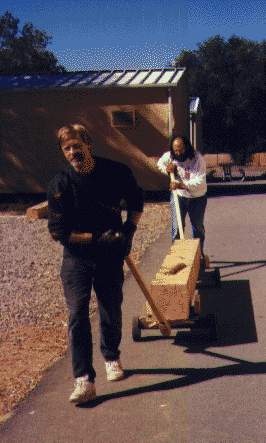 |
| Since we had no permanent
working space, each beam had
to be moved several times. The swivel-wheeled beam carriers saved many
backs and muscles (in this case, mine and David's).
Here is how to make them.
|
We got the OK for the carving concept, and engaged professional
carvers David Parsons and Toby Bringas to hold workshops to teach
us the tricks of the trade. We also purchased chisels, (some of which
actually were generously donated by Woodworker's Supply in Albuquerque).
The attendance at the workshops was huge, with about 30 families showing
up. Ann spent time in each classroom, collecting ideas from the children
about what they would like to see on the beams. In the new building, there
would be 15 classrooms, and having a different beam over each room sounded
like a great plan. In addition, there were dozens of beams in archways in
the hallways.
Here, however, we ran into unexpected opposition. It
seemed that when the carving project was first proposed, some on the
architecture committee were just thinking of lines and notches, and not of
the full-fledged bas-reliefs that were now being sketched. All this art
stuff was obviously too much for the more straight-laced members of the
architectural committee, and since they declared themselves in charge of
the beam carving committee, rather than their equals, we essentially were
declared to have no say in the matter. The net result was that in the end
we were only allowed to put designs on 7 beams. Had it been up to us, we
would have had carvings for each classroom, and maybe more.

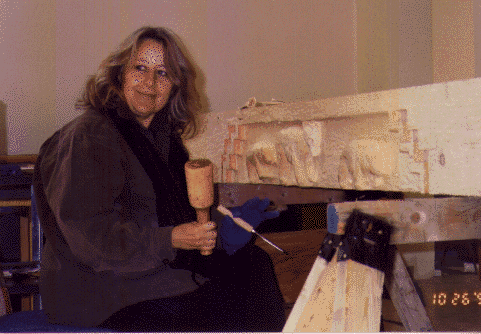 |
| Janet working on the bears
|
There were actually 3 kinds of beams:
(1) the beams over the
classroom doors. There were 21 of them, 10x10", and typically 8'
long, and were reasonably managable.
(2) Beams in the hallways -
10x10", but typically 10 or 12' long; there were 74 of these.
(3) Beams for the lobby ceiling - 12x12", 22' long; there were
13 of these monsters.
The remodeling was done in two major phases, with the Western half of the
school being done first, and the Eastern half second. Initially, we were
only going
to do the classroom beams. For the first phase, there were 4 sculpted beams
(birds, snake, fish, lizards), and the remaining 6 were just
chipped (like in the picture near the top of this page).
As the classroom beams for the the first phase of the renovation
(the Western half of the building) were nearing completion, the contracter
got further and further behind schedule, and we were starting to consider
chipping the hall beams, which were larger and more numerous. Charles Brunn
and I decided that we could indeed do the job, but we needed to hurry,
since the first of the hall beams were already going up, unchipped. By the
time we got permission, about 5 pairs of beams were already installed, in
the NW and W corridors. For many evenings we worked like mad to stay ahead
of the framing crew, chipping beams before installation, and doing the
backbraking chipping in place. (You can tell which ones were done in place
by the fact that the chisel strokes terminate at the wall surface. Also,
after having done one or two undersides, I modified a power planer to do
the undersides by machine. Charles, Janet, Ann, David S., Anita and I
finally got the beams for the Western half done.

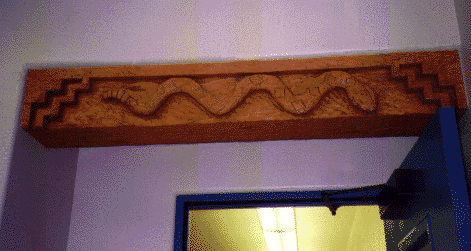 |
| The snake, who ended up over
the door to what is currently the kindergarten room
|
All along, we had considered the lobby beams an impossible job,
and had
never sought to chip them. They were the 22' 12x12, and at more than 850
pounds apiece, could not be
lifted by us. However, I had my modified power planer now, and I had been
looking at this pile of monster beams, sitting there in the middle of the
unfinished lobby, getting dirtier by the day. One night I went there
alone - Charles was out of town -,
and did one surface with the planer. This did not take too long. I
experimented a bit with a lever and blocks to see if I could budge these
beams; this proved not impossible. Finally I decided it was now or never,
and started doing them. The contracter was going to start installing them
the next day - for real this time. I chipped all those beams in two very
long nights of hard work - planing, lifting, stacking and unstacking,
rotating these long
behemoths singlehandedly. Now I know how the pyramids were built.

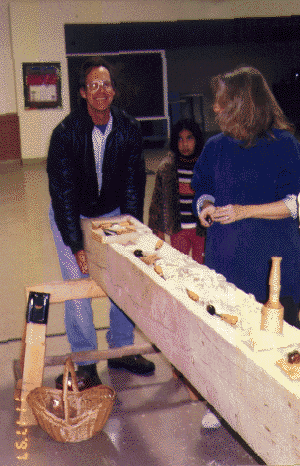 |
| Daniel and his daughter
Elizabeth, and Janet, working on the roadrunner beam
|
Here is the core team:
Janet Russek, photographer.
David Scheinbaum, photographer, professor at the College of Santa Fe
Janet and David are married, and are dealers in vintage photographs.
Ann Brunson, art teacher. Ann had just moved to Santa Fe from Texas.
Hubert van Hecke, yours truly, physicist (look me up in Phys Rev!), a
green card holder from Holland.
David Parsons and Toby Bringas of course played a special role. Initially
hired for a small fee to give two workshops on carving and
bas-relief, they stuck around till the very end. They put the
finishing touches on most sculpted beams. Right now (December 1997),
David is
finishing up 73 24x26' bas-relief panels for the State Library on
Cerillos Road. Go look.
Charles Brunn, contractor. As a contractor, there were periods when he had
not much work, and at those times could spend enormous amounts of
time on the project. Especially near the end of phase 1, he
negotiated daily with the framers, keeping beams and schedules sorted
out, and then chipped a pile of beams.
Daniel Morper, painter/lawyer joined for the second phase, and took the
lead on the roadrunner beam.
Each of us developed his/her own style of chipping. For example, the long
sinuous strokes are mine, and the dramatic star patterns are Charles'.
Janet and Ann had shorter strokes.

 |
| The lizards, over the door to
xxx's class |
We are ever
grateful for our unending source of beam carvers (listed
alphabetically); to
Justa (Wood Gormley alumni, 1996) and Ricci Armijo and their grandfather,
Eluterio Barela, who was an inspiration to everyone involved (deceased,
1997), to Ivan and Joss Barnett, to Phillip and Randal Briggs,
Trey Brunson, Ann's son, and his grandfather, Bill Patty, to Carol Cardin and children,
to Charlene Cerny and Elizabeth and Catherine Chipman-Cerny and Joe
Chipman,
to Mark, Dylan and Hannah Currie, to Iora Dop, to Billie, Ryan and
Driscoll, to Jo Ellis, to Patrick, Mariana, Kelsy and Kaitlin Avalos-Feehan
, to Sonya, Ron and Desiree Jacobs, to Denise Johnson, to Paul, Lisa and
Daniel Kaufman, to Stephen, Christie and Ben Lauer, to Jared Lindsay, to
Sina and Martha Littlebird, to Tim, Teresa and Kimberly Lopez, to Sam
Mauldin, to Carol Medrano, to Daniel and Elizabeth Morper, to Barry, Raoul
and Liesette-Mimi Paisner, to Michael Rea, to Sandy and Hallie Richards,
to
Kent and Pam Scarborough, to David and Zachary Scheinbaum, to Paul, Karyn
and Trevor Schmitt, to Linda and Paul Tachau, to Debbie, Kelly and Travis
Urig, to Anita and Rosie West, to Victor, Eric and Lee Wulc, to Larry and
Talia Wang, to Laura Wilson (a Santa Fe Living Treasure) and many others
whose names were never left for us to record. (But if you know of missing
names, please let me know and I'll
add them)

 |
| The fish, over the door to
ms. Esquibel's class (3rd grade) |
 Last update 23 Jan 98 - HvH
Last update 23 Jan 98 - HvH
Up to the Wood-Gormley links
Up to my home page
















